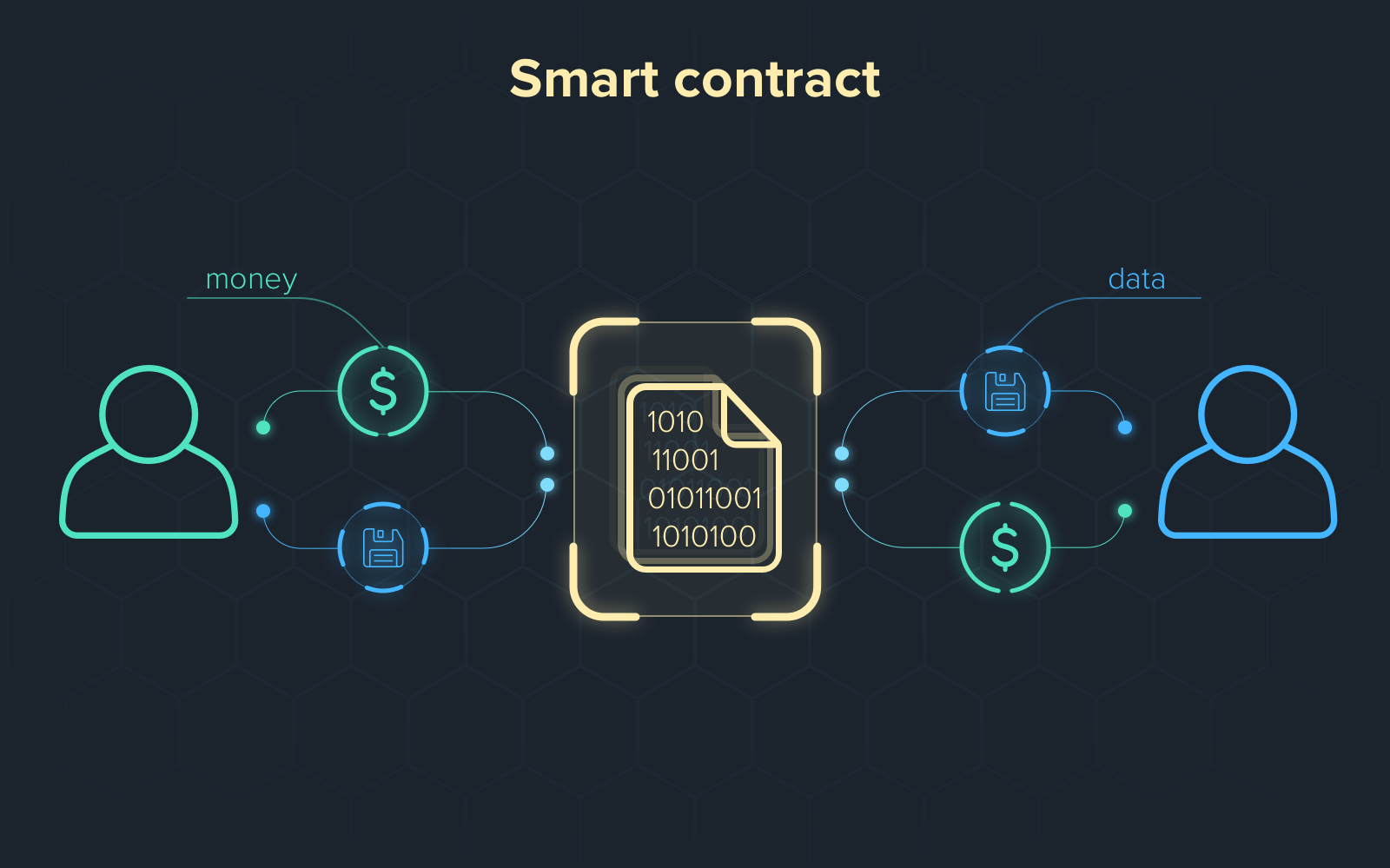Introduction
Welcome to this comprehensive article on the topic of smart contract storage on the blockchain. In today’s rapidly evolving digital landscape, blockchain technology has gained significant attention for its potential to revolutionize industries and bring about a new era of transparency and decentralization. A key component of blockchain technology is the concept of smart contracts, which have the potential to automate and enforce the execution of contractual agreements in a secure and efficient manner.
In this article, we will delve into the world of smart contracts, exploring their functionality and the role they play in the blockchain ecosystem. Specifically, we will focus on the storage aspect of smart contracts and examine where they are stored within the blockchain infrastructure.
Understanding the storage of smart contracts is essential for comprehending their broader applications and implications. By analyzing the underlying mechanisms and storage methods, we can better appreciate the benefits and challenges associated with this groundbreaking technology.
Before we explore the intricacies of smart contract storage, let’s first take a closer look at what smart contracts are and how they work within the blockchain ecosystem.
What are Smart Contracts?
Smart contracts are self-executing contracts with predefined rules and conditions that are written in code and stored on a decentralized blockchain network. These contracts facilitate the exchange of digital assets, data, or services between parties without the need for intermediaries.
Unlike traditional contracts, smart contracts are programmed to automatically execute actions when specific conditions are met. The code within a smart contract is immutable and transparent, providing a trustless environment that eliminates the need for manual verification and enforcement.
Smart contracts are designed to operate on a “if-then” logic. They contain a set of predefined rules and conditions that must be met for the contract to execute the specified actions. For example, if party A transfers a certain amount of cryptocurrency to party B, then party B will automatically transfer a specified digital asset or service to party A.
One key advantage of smart contracts is their ability to eliminate the potential for human error and remove the need for intermediaries or trusted third parties. The code within smart contracts ensures that transactions occur exactly as agreed upon, leaving no room for ambiguity or misinterpretation.
Smart contracts are not limited to financial transactions. They have the potential to revolutionize various industries such as real estate, supply chain management, insurance, and more. By automating and enforcing contractual agreements, smart contracts can streamline processes, reduce costs, and increase efficiency.
Now that we have a basic understanding of what smart contracts are, let’s explore how they work within the blockchain ecosystem.
How Do Smart Contracts Work?
Smart contracts operate on the principles of blockchain technology, utilizing its decentralized and immutable nature to ensure the secure and transparent execution of contractual agreements.
When a smart contract is created, it is written in code using programming languages specifically designed for smart contract development, such as Solidity for Ethereum. The contract is then deployed onto a blockchain network, where it becomes part of the distributed ledger.
Once deployed, the smart contract can be accessed and interacted with by parties who have the necessary permissions. These parties can be individuals, organizations, or even autonomous agents, depending on the use case.
Interacting with a smart contract involves sending transactions to it. These transactions contain instructions for the contract to execute certain actions based on predefined conditions. For example, a transaction may request the transfer of a specific digital asset to a designated recipient.
Once the conditions specified in the smart contract are met, the contract’s code is automatically executed, and the desired actions are carried out. This execution occurs on every participating node in the blockchain network, ensuring that the contract’s operation is decentralized, secure, and verifiable by all network participants.
One of the key features of smart contracts is their immutability. Once a smart contract is deployed on the blockchain, its code cannot be altered or tampered with. This ensures that the agreed-upon rules and conditions remain unchanged, providing a level of trust and reliability in the execution of the contract.
Additionally, smart contracts can interact with other smart contracts and external data sources through a process known as “Oracles.” Oracles provide real-world data to the smart contract, enabling it to make informed decisions and automate actions based on external events.
Overall, the workings of smart contracts within the blockchain ecosystem involve the deployment of code onto a decentralized network, interaction through transactions, automatic execution based on predefined conditions, and immutability to ensure trust and transparency.
Now that we understand how smart contracts operate, let’s delve into where exactly these contracts are stored within the blockchain infrastructure.
Where are Smart Contracts Stored?
Smart contracts are stored within the blockchain infrastructure, but the exact location and storage method can vary depending on the type of blockchain network being utilized.
In public blockchains such as Ethereum, smart contracts are stored on every participating node of the network. Each node maintains a complete copy of the blockchain, which includes all the smart contracts deployed on the network. This ensures that the contract’s code and data are replicated and stored across multiple nodes, providing redundancy and resilience.
Within the blockchain data structure, smart contracts are typically stored in a specific section called the “contract state.” This section contains the code of the smart contract, as well as any associated data or variables defined within the contract. The contract state is stored within each block of the blockchain, forming a historical record of all contract transactions and interactions.
When a new smart contract is deployed, a transaction is created and included in a block on the blockchain. This transaction contains the bytecode or code representation of the smart contract, which is then executed by the network’s consensus mechanism. Once the transaction is validated and added to the blockchain, the smart contract becomes part of the contract state and is accessible for further interaction.
In addition to the contract state, some blockchain networks also utilize a separate storage layer known as “contract storage” or “contract storage trie.” This storage layer is used to store contract-specific data, such as the values of variables or the state of the contract at a particular point in time. Contract storage provides efficient and persistent storage for smart contract data that may be accessed or modified throughout the contract’s lifespan.
In contrast, private or consortium blockchains may have different storage mechanisms for smart contracts. These networks are typically operated by a single organization or a group of entities with specific access controls. In such cases, smart contracts may be stored within a centralized database or distributed amongst the participating nodes of the network.
Regardless of the type of blockchain network, the storage of smart contracts is designed to ensure immutability, transparency, and accessibility. The distributed nature of public blockchains and the controlled environment of private blockchains both contribute to the secure and reliable storage of smart contracts.
Now that we have explored where smart contracts are stored, let’s gain a basic understanding of the underlying technology that powers blockchains.
The Basics of Blockchain Technology
Blockchain technology is a decentralized and distributed ledger system that allows for the secure and transparent recording of transactions. It serves as the foundation for various applications, including cryptocurrencies, smart contracts, and more.
At its core, a blockchain is a chain of blocks, where each block contains a list of transactions. These transactions are grouped together, verified, and then added to the blockchain in a chronological order.
One of the key features of blockchain technology is its decentralized nature. Unlike traditional centralized systems where a single entity or authority controls the data, blockchain operates on a network of computers known as nodes. These nodes work together to maintain and validate the blockchain by reaching a consensus on the validity of transactions.
Each block in the blockchain contains a unique identifier called a hash, which is a cryptographic representation of the block’s data. The hash of each block also includes the hash of the previous block in the chain, forming a link between blocks and creating the immutability of the blockchain. This means that once a block is added to the chain, it cannot be changed without invalidating the entire chain.
Blockchain technology utilizes various consensus mechanisms to ensure the agreement of all network participants on the validity and order of transactions. Popular consensus mechanisms include Proof of Work (PoW), where participants solve complex mathematical puzzles to validate transactions, and Proof of Stake (PoS), where participants “stake” their cryptocurrency holdings to secure the network.
By distributing the ledger across multiple nodes and employing cryptographic algorithms, blockchain technology provides a high level of security and eliminates the need for a central authority to validate transactions. This decentralization and transparency make it difficult for any single entity to manipulate the data on the blockchain, ensuring trust and reliability in the system.
There are different types of blockchains, including public blockchains, private blockchains, and consortium blockchains. Public blockchains, like Bitcoin and Ethereum, are open to anyone and can be accessed and used by anyone. Private blockchains are restricted to a specific group of participants, and consortium blockchains are governed by a consortium of organizations.
With an understanding of the basics of blockchain technology, we can now explore how smart contracts fit within the blockchain ecosystem and the specific storage methods used for smart contracts.
Types of Blockchains
Blockchains can be classified into different types based on their accessibility, governance, and permission levels. Let’s explore the three main types of blockchains: public, private, and consortium blockchains.
1. Public Blockchains: Public blockchains are open and permissionless networks that are accessible to anyone. They operate on a decentralized model where anyone can participate in the network, validate transactions, and create smart contracts. Examples of public blockchains include Bitcoin and Ethereum. Public blockchains provide high transparency and security but can be slower and have higher transaction fees due to the large number of participants and computational requirements.
2. Private Blockchains: Private blockchains, also known as permissioned blockchains, are restricted networks where access and participation are controlled by a central authority or a specific group of participants. These blockchains are often used by organizations for internal purposes or to create industry-specific solutions. Private blockchains may provide more scalability and privacy compared to public blockchains, but they sacrifice some decentralization and transparency.
3. Consortium Blockchains: Consortium blockchains are a hybrid between public and private blockchains. They involve a group of organizations that come together to form a consortium and jointly participate in the blockchain network. Consortium blockchains offer a shared infrastructure that enables collaboration and information sharing among trusted parties. These blockchains maintain a degree of decentralization while providing more control and faster transaction processing compared to public blockchains.
Each type of blockchain has its own set of use cases and advantages. Public blockchains are ideal for projects that require a high level of decentralization, trust, and openness, such as cryptocurrency transactions and global financial systems.
Private blockchains, on the other hand, are suitable for scenarios where privacy, efficiency, and control are paramount, such as supply chain management and internal business processes. They are often used by enterprises seeking to leverage blockchain technology within their organization while maintaining control over access and data privacy.
Consortium blockchains are beneficial when multiple organizations collaborate on a shared infrastructure, such as in industry-specific consortia or inter-organizational supply chains. They provide a balance between the transparency and security of public blockchains and the control and efficiency of private blockchains.
Now that we understand the different types of blockchains, let’s delve into the structure of a blockchain and how it facilitates the storage and execution of smart contracts.
The Structure of a Blockchain
A blockchain is composed of a series of interconnected blocks, each containing a list of transactions. These blocks are linked together in a chronological and immutable manner, forming a decentralized and transparent ledger system.
The structure of a blockchain can be divided into three main components: blocks, transactions, and the consensus mechanism.
1. Blocks: A block is a container that holds a set of verified and validated transactions. Each block contains a unique identifier called a hash, which is generated by applying cryptographic functions to the block’s data. The hash not only represents the content of the block but also contains the hash of the previous block, creating a chain-like structure. This linking of blocks provides the immutability and integrity of the blockchain.
2. Transactions: Transactions represent the actions or exchanges of data, assets, or services recorded on the blockchain. These transactions contain relevant information such as sender and receiver addresses, the amount or type of asset being exchanged, and any additional data required by specific use cases. Transactions are validated by network participants based on the consensus mechanism of the blockchain network before being included in a block.
3. Consensus Mechanism: The consensus mechanism is the algorithm or rule set employed by a blockchain network to ensure agreement on the validation and ordering of transactions. It plays a crucial role in maintaining the integrity, security, and decentralization of the blockchain. Popular consensus mechanisms include Proof of Work (PoW) and Proof of Stake (PoS), each with its own approach to achieving consensus and adding new blocks to the chain.
The decentralized and distributed nature of the blockchain ensures that each participant in the network possesses a copy of the entire blockchain ledger. This redundancy and replication of data enhance the security, fault tolerance, and availability of the blockchain. Additionally, the transparency of the blockchain allows for public verification and auditing of transactions, fostering trust among network participants.
Smart contracts, as self-executing agreements, are an integral part of the blockchain structure. They are stored within blocks, alongside other transactions, and are executed by the network participants following the consensus mechanism. The inclusion of smart contracts in the blockchain provides additional functionality and automation capabilities, enabling complex and decentralized applications.
Now that we have covered the structure of a blockchain, let’s focus specifically on the storage of smart contracts on different types of blockchains.
Smart Contracts on Blockchain
Smart contracts are an integral part of blockchain technology, offering automation and self-execution of agreements in a secure and transparent manner. By leveraging the decentralized nature of blockchain networks, smart contracts enable parties to engage in complex transactions without relying on intermediaries or centralized authorities.
Blockchain platforms such as Ethereum are designed specifically to support the deployment and execution of smart contracts. These platforms provide a programmable framework that allows developers to write smart contract code using specialized programming languages like Solidity.
Smart contracts on blockchain operate based on predefined rules and conditions that are encoded in the contract’s code. Once deployed on the blockchain, smart contracts can be interacted with by authorized parties, triggering the execution of specific actions when the contract’s conditions are met.
Smart contracts are stored within the blockchain infrastructure, typically alongside other transaction data, in a manner that ensures their security, immutability, and accessibility to network participants. The code of a smart contract is stored within blocks, forming part of the blockchain’s history and creating a transparent record of the agreement.
One of the main benefits of smart contracts on blockchain is the elimination of intermediaries. Smart contracts enable direct peer-to-peer transactions, reducing the need for trusted third parties and streamlining the process. This not only saves time and costs but also reduces the risk of human error or fraud associated with traditional contract execution.
Additionally, smart contracts provide transparency and auditability. All transactions and interactions with the smart contract are recorded on the blockchain, allowing for public verification and auditing. This level of transparency ensures trust among parties, as well as accountability in the execution of contractual agreements.
Smart contracts on the blockchain have the potential to revolutionize various industries. They can be used to automate financial transactions, enable decentralized applications, facilitate supply chain management, and even enhance the voting process. By leveraging the power of blockchain technology, smart contracts enable the creation of innovative solutions that are secure, transparent, and efficient.
Now, let’s explore the different approaches to smart contract storage on public and private blockchains.
Smart Contract Storage on Public Blockchains
Smart contract storage on public blockchains, such as Ethereum, follows a decentralized approach that ensures transparency, security, and accessibility to all network participants. In public blockchains, smart contracts are stored on every participating node, forming a globally distributed and redundant storage system.
When a smart contract is deployed on a public blockchain, a transaction is created and included in a block. This transaction contains the bytecode or code representation of the smart contract, which is then executed by the network’s consensus mechanism. Once the transaction is validated and added to the blockchain, the smart contract becomes part of the contract state.
The contract state is a specific section within the blockchain data structure that stores the code and data associated with smart contracts. It serves as a historical record of all transactions and interactions involving the smart contract. The contract state is replicated on every node in the network, ensuring that the smart contract’s code and data are available to all participants.
Public blockchains also utilize a mechanism called “gas” to ensure the execution and storage of smart contracts. Gas is a unit of measurement that represents the computational effort required to perform an operation or execute a transaction on the blockchain. Participants who wish to interact with smart contracts must pay gas fees to compensate the network for the computational resources utilized.
The decentralized storage of smart contracts on public blockchains contributes to their security and reliability. Since the contracts are stored on multiple nodes in the network, there is no single point of failure or vulnerability that can compromise the integrity of the contract. This distributed nature of storage also enhances fault tolerance, as the blockchain can continue to function even if some nodes go offline or become compromised.
Furthermore, the transparency of public blockchains allows anyone to verify the code and data of a smart contract, ensuring that it operates as intended and eliminating the need to rely solely on trust. This transparency is particularly important for auditors, regulators, and participants who want to validate the integrity of the contract.
While public blockchains provide high transparency and security, they also face challenges such as scalability and cost. The distributed nature and consensus mechanisms of public blockchains can result in slower transaction processing times and higher transaction fees compared to private blockchains. However, ongoing research and development efforts are focused on addressing these challenges to make public blockchains more scalable and cost-effective.
Now that we have explored smart contract storage on public blockchains, let’s turn our attention to the storage of smart contracts on private blockchains.
Smart Contract Storage on Private Blockchains
Smart contract storage on private blockchains differs from that of public blockchains due to the centralized and controlled nature of these networks. In private blockchains, smart contracts are typically stored within a centralized database or distributed among the participating nodes of the network.
In a private blockchain, access to the network and participation in the consensus process is restricted to a specific group of participants. These participants are often trusted entities or organizations that have predefined access permissions. Because of this controlled environment, smart contract storage can take various forms based on the specific architecture and design of the private blockchain network.
In some cases, smart contracts on private blockchains are stored within a centralized database that is managed by a single entity or a consortium of trusted organizations. This approach allows for efficient storage and retrieval of smart contract data within a controlled environment. It also provides flexibility in terms of data retrieval and integration with existing systems and databases.
Alternatively, smart contracts can be stored on distributed storage systems within the private blockchain network. The storage of smart contracts in this model is similar to that of public blockchains, where each participating node stores a copy of the blockchain and the associated smart contract data. This distributed storage offers redundancy and fault tolerance, ensuring that the smart contract data persists even if some nodes go offline or become compromised.
Private blockchains generally prioritize privacy and control, which makes them suitable for situations where participants require a high degree of confidentiality. These blockchains are commonly employed by organizations or consortiums that want to collaborate and share data while maintaining strict control over access and data privacy.
Compared to public blockchains, private blockchains typically offer higher transaction throughput and lower operational costs due to their centralized architecture and reduced number of participants. These features make private blockchains attractive for applications that require fast transaction processing and data confidentiality.
Ongoing advancements in blockchain technology are also introducing interoperability between private and public blockchains. This means that it may be possible to have private blockchains that leverage the security and transparency of public blockchains, while still maintaining control over data privacy and access permissions.
Overall, smart contract storage on private blockchains differs from that of public blockchains due to the centralized and controlled nature of private networks. The storage mechanism chosen depends on the specific architecture and requirements of the private blockchain deployment.
With an understanding of smart contract storage on both public and private blockchains, let’s now examine the benefits and challenges associated with storing smart contracts on the blockchain.
Benefits of Smart Contract Storage on Blockchain
The storage of smart contracts on the blockchain offers numerous advantages that contribute to the security, transparency, and efficiency of contractual agreements. Let’s explore some of the key benefits of storing smart contracts on the blockchain.
1. Immutability: Smart contracts stored on the blockchain are immutable, meaning they cannot be altered or tampered with once deployed. This feature ensures the integrity and reliability of the contract, as the agreed-upon terms and conditions cannot be modified without the consensus of the network participants. Immutability reduces the risk of fraud and ensures that contractual agreements are executed exactly as intended.
2. Transparency: Blockchain technology provides transparency by recording all transactions and interactions with smart contracts on a distributed ledger. All participants in the network can view and verify the content of a smart contract, ensuring a high level of transparency and trust. This transparency can significantly reduce disputes and the need for intermediaries, as the parties involved can independently verify the execution of the contract.
3. Security: Storing smart contracts on the blockchain enhances security. The decentralized and distributed nature of blockchains makes it difficult for malicious actors to compromise or manipulate the contract’s code or data. Additionally, the cryptographic techniques employed in blockchain networks protect the confidentiality and integrity of the smart contracts, ensuring that only authorized parties can access and modify the contract.
4. Efficiency and Automation: Smart contracts automate the execution of contractual agreements, removing the need for manual intervention and streamlining the process. By storing smart contracts on the blockchain, parties can automate the enforcement of contract terms and conditions, reducing processing time, minimizing errors, and increasing efficiency. This automation can lead to significant time and cost savings while enabling faster and more accurate execution of contractual obligations.
5. Trust and Elimination of Intermediaries: Storing smart contracts on the blockchain eliminates the need for intermediaries or trusted third parties to enforce and verify agreements. The code and logic embedded within smart contracts ensure that the contract executes exactly as programmed, reducing reliance on trust and intermediaries. This trustless environment enhances security and reduces costs associated with intermediaries.
6. Accessibility and Interoperability: Blockchain networks provide a shared infrastructure that enables global accessibility and interoperability of smart contracts. Smart contracts stored on the blockchain can be accessed and interacted with by authorized parties worldwide, allowing for seamless collaboration and cross-border transactions. This accessibility and interoperability can foster innovation and open up new opportunities for businesses and individuals.
These benefits demonstrate the transformative potential of storing smart contracts on the blockchain. By leveraging the features of blockchain technology, the storage of smart contracts enhances security, transparency, efficiency, and trust in contractual agreements.
Next, let’s explore the challenges associated with the storage of smart contracts on the blockchain.
Challenges of Smart Contract Storage on Blockchain
While the storage of smart contracts on the blockchain offers numerous benefits, there are also various challenges associated with this technology. It is important to be aware of these challenges to ensure the successful implementation and utilization of smart contracts. Let’s explore some of the key challenges:
1. Security Vulnerabilities: Smart contracts are executed based on their underlying code, and any vulnerabilities or flaws in the code can be exploited by attackers. Issues such as reentrancy attacks, overflow vulnerabilities, or code bugs can result in financial losses or unauthorized access to sensitive information. Thorough code audits, security best practices, and testing are essential to mitigate these risks and ensure the security of smart contracts.
2. Enforceability of Legal Contracts: While smart contracts automate and enforce contractual agreements, legal enforceability can be a challenge. As smart contracts operate within the realm of code and technology, there may be limitations in addressing complex legal frameworks or resolving disputes that require interpretation of subjective or ambiguous contractual clauses. Bridging the legal and technical aspects of smart contracts is an ongoing challenge that requires collaboration and legal innovation.
3. Scalability: Scalability is a well-known challenge in many blockchain networks, including those hosting smart contracts. As the number of transactions and contract interactions increases, the network’s capacity to process and store data may become a limiting factor. Addressing scalability challenges requires technological advancements, such as layer 2 solutions, sharding, or off-chain channels, to achieve higher transaction throughput and reduce congestion on the blockchain network.
4. Complexity and Learning Curve: Developing, deploying, and interacting with smart contracts requires knowledge of blockchain technology and programming languages specifically designed for smart contract development. The complexity and learning curve associated with understanding the intricacies of smart contract development can act as a barrier to entry for individuals and organizations looking to utilize this technology. Educating developers and providing user-friendly tools and frameworks can help mitigate this challenge.
5. Upgradability and Governance: Once a smart contract is deployed on the blockchain, it becomes difficult to modify or upgrade without careful planning and consideration. This lack of upgradability can pose challenges when there are necessary changes or improvements required in the contract’s functionality or logic. Additionally, the governance of smart contracts within a blockchain network, including decisions related to upgrades or changes, can be complex and may require consensus among network participants.
6. Legal and Regulatory Compliance: The adoption of smart contracts raises legal and regulatory considerations. Different jurisdictions may have varying approaches or laws related to smart contracts, which may impact their enforceability or compliance requirements. Ensuring compliance with existing legal frameworks and working towards harmonization between blockchain technology and legal systems is an ongoing challenge that requires collaboration among industry stakeholders.
Awareness and proactive management of these challenges will contribute to the successful implementation of smart contract storage on the blockchain. Advancements in technology, education, regulatory frameworks, and best practices will continue to address these challenges and further drive the adoption and potential of smart contracts.
Now that we have explored both the benefits and challenges of smart contract storage on the blockchain, let’s summarize the key points discussed and conclude this comprehensive article.
Conclusion
In conclusion, smart contract storage on the blockchain offers a range of benefits and presents unique challenges. Smart contracts, which are self-executing agreements written in code, provide automation, transparency, and efficiency in contractual arrangements. The storage of smart contracts on the blockchain ensures immutability, transparency, and accessibility to network participants, whether it be on public, private, or consortium blockchains.
Public blockchains enable decentralized storage of smart contracts, with each participating node maintaining a copy of the contract state. This approach ensures transparency, security, and the elimination of intermediaries, while also facing challenges such as scalability and cost. Private blockchains, on the other hand, provide controlled and centralized storage, prioritizing privacy and efficiency. However, they sacrifice some aspects of decentralization and transparency.
Storing smart contracts on the blockchain brings several benefits, including immutability, transparency, security, efficiency, and trust elimination. Smart contracts automate contractual agreements, reduce the risk of human error, and streamline processes. The transparency of the blockchain allows for public verification, increasing accountability and reducing disputes. Additionally, smart contract storage provides a foundation for interoperability and global accessibility.
Despite the numerous benefits, challenges exist. Security vulnerabilities in smart contract code pose risks that require robust auditing and testing processes. Legal and regulatory compliance introduces complexities that need to be navigated. Scalability remains a challenge, particularly when dealing with a high volume of transactions. The complexity of smart contract development and the difficulty of upgradability and governance add additional considerations that must be addressed.
To overcome these challenges, continuous research, education, and collaboration are crucial. Advancements in technology, industry standards, and legal frameworks will pave the way for wider adoption and increased efficiency in smart contract storage on the blockchain.
In summary, smart contract storage on the blockchain revolutionizes the way contractual agreements are executed, offering increased security, transparency, and efficiency. By leveraging the decentralized and immutable nature of blockchain technology, smart contracts pave the way for a new era of automation and trust in various industries.

























